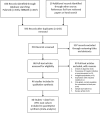Changing trends in the prevalence of H. pylori infection in Japan (1908-2003): a systematic review and meta-regression analysis of 170,752 individuals
- PMID: 29138514
- PMCID: PMC5686167
- DOI: 10.1038/s41598-017-15490-7
Changing trends in the prevalence of H. pylori infection in Japan (1908-2003): a systematic review and meta-regression analysis of 170,752 individuals
Abstract
Changing trends in the prevalence of H. pylori infection in the general population over time are thought to be the main driving force behind the declining gastric cancer mortality in Japan. However, whether the prevalence of H. pylori infection itself shows a birth-cohort pattern needs to be corroborated. We performed a systematic review of studies that reported the prevalence of H. pylori infection among Japanese individuals. Meta-regression was conducted in the framework of a generalized additive mixed model (GAMM) to account for heterogeneity in the prevalence of H. pylori infection as a function of birth year. The prevalence of H. pylori infection confirmed a clear birth cohort pattern: the predicted prevalence (%, 95% CI) was 60.9 (56.3-65.4), 65.9 (63.9-67.9), 67.4 (66.0-68.7), 64.1 (63.1-65.1), 59.1 (58.2-60.0), 49.1 (49.0-49.2), 34.9 (34.0-35.8), 24.6 (23.5-25.8), 15.6 (14.0-17.3), and 6.6 (4.8-8.9) among those who were born in the year 1910, 1920, 1930, 1940, 1950, 1960, 1970, 1980, 1990, and 2000, respectively. The present study demonstrated a clear birth-cohort pattern of H. pylori infection in the Japanese population. The decreased prevalence of H. pylori infection in successive generations should be weighed in future gastric cancer control programs.
Conflict of interest statement
The authors declare that they have no competing interests.
Figures
Similar articles
-
Rapidly decreasing prevalence of Helicobacter pylori among Japanese children and adolescents.J Infect Chemother. 2019 Jul;25(7):526-530. doi: 10.1016/j.jiac.2019.02.016. Epub 2019 Apr 17. J Infect Chemother. 2019. PMID: 31003956
-
Changing epidemiology of Helicobacter pylori in Japan.Gastric Cancer. 2017 Mar;20(Suppl 1):3-7. doi: 10.1007/s10120-016-0658-5. Epub 2016 Oct 18. Gastric Cancer. 2017. PMID: 27757699 Review.
-
Prevalence of Helicobacter pylori infection by birth year and geographic area in Japan.Helicobacter. 2014 Apr;19(2):105-10. doi: 10.1111/hel.12110. Epub 2014 Feb 10. Helicobacter. 2014. PMID: 24506211
-
Declining trends in prevalence of Helicobacter pylori infection by birth-year in a Japanese population.Cancer Sci. 2015 Dec;106(12):1738-43. doi: 10.1111/cas.12821. Epub 2015 Oct 30. Cancer Sci. 2015. PMID: 26395018 Free PMC article.
-
The Increasing Trend of the Generational Helicobacter pylori-Naïve Prevalence Among Japanese Individuals Born Between 1925 and 2015: A Systematic Review and Meta-Regression Analysis.Helicobacter. 2025 May-Jun;30(3):e70052. doi: 10.1111/hel.70052. Helicobacter. 2025. PMID: 40500921
Cited by
-
Burden of cancer attributable to modifiable factors in Japan in 2015.Glob Health Med. 2022 Feb 28;4(1):26-36. doi: 10.35772/ghm.2021.01037. Glob Health Med. 2022. PMID: 35291201 Free PMC article.
-
Population-based X-ray gastric cancer screening in Hiroshima prefecture, Japan.World J Clin Oncol. 2024 Feb 24;15(2):271-281. doi: 10.5306/wjco.v15.i2.271. World J Clin Oncol. 2024. PMID: 38455140 Free PMC article.
-
An age-period-cohort analysis of mortality rates for stomach, colorectal, liver, and lung cancer among prefectures in Japan, 1999-2018.Environ Health Prev Med. 2020 Dec 5;25(1):80. doi: 10.1186/s12199-020-00922-0. Environ Health Prev Med. 2020. PMID: 33278883 Free PMC article.
-
Updated Trends in Cancer in Japan: Incidence in 1985-2015 and Mortality in 1958-2018-A Sign of Decrease in Cancer Incidence.J Epidemiol. 2021 Jul 5;31(7):426-450. doi: 10.2188/jea.JE20200416. Epub 2021 Feb 6. J Epidemiol. 2021. PMID: 33551387 Free PMC article.
-
Efficacy of second-line regimens for Helicobacter pylori eradication treatment: a systemic review and network meta-analysis.BMJ Open Gastroenterol. 2020 Sep;7(1):e000472. doi: 10.1136/bmjgast-2020-000472. BMJ Open Gastroenterol. 2020. PMID: 32883715 Free PMC article.
References
Publication types
MeSH terms
LinkOut - more resources
Full Text Sources
Other Literature Sources
Medical



